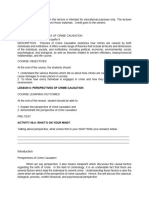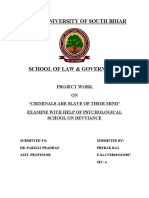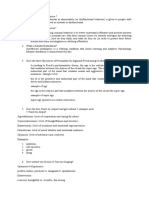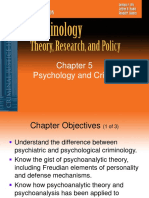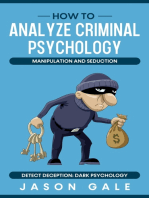Modern English II
Modern English II
Uploaded by
api-329152398Copyright:
Available Formats
Modern English II
Modern English II
Uploaded by
api-329152398Original Title
Copyright
Available Formats
Share this document
Did you find this document useful?
Is this content inappropriate?
Copyright:
Available Formats
Modern English II
Modern English II
Uploaded by
api-329152398Copyright:
Available Formats
Modern English II
Stacy Wen
5/16/16
The focus of criminal behavior study is to understand the offender
better and try to figure out the reasons behind their crime. The basic study
to learn about criminal behavior includes defining criminal behavior,
understanding theories of crime behavior and knowing how to predict crime
in the near future.
First of all, there are three ways of defining criminal behavior. The most
common approach equates it with criminality and delinquency. Criminality is
defined as any activities that result in criminal prosecution or incarceration.
Delinquency is defined as engagement in unlawful activities while under the
age of 18. Information on these types of criminal behavior can be collected
either through police and court records of criminal offences or via
anonymous self-reports of participation in activities that would be considered
criminal. The second approach is to use diagnostic criteria for various
personality disorders that are associated with an increased risk of criminal
behavior. For example, antisocial Personality Disorder (ASPD) is characterized
by a persistent disregard for the rights of others. It can only be diagnosed in
individuals over the age of 18. There are also some childhood disorders like
Attention Deficit Hyperactivity Disorder (ADHD), Conduct Disorder (CD) and
Oppositional Defiant Disorder (CDD), which are distinguished by frequent
inattention and hyperactivity-impulsivity. These disorders also have been
identified as risk factors for development of ASPD. A third approach to
criminal behavior has been to investigate personality traits. It recently
became essential in the diagnosis of individuals with antisocial or criminal
behavior (Jones). Aggressiveness and impulsivity are the most heavily
researched traits that may be risk factors for engaging in criminal behavior.
They are usually assessed by personality questionnaires. Adults
hyperactivity, which is often appearing as ADHD, may also be one of the
interests because individuals who exhibit both antisocial and hyperactive
behavior are more likely to be a criminal (Chakraborty).
Many theories have also been appeared since the beginning of the
study of criminal behavior. Biological theories support that criminal behavior
is caused by some flaw in individuals biological makeup. Some people
believe that the causes are the heredity, neurotransmitter dysfunction and
brain abnormalities. Others support that personality of offenders is iddominated, which means that when they lose control of the ago, their idea of
instant gratification takes over. There are also several types of crime control
that are involved with artificial interference in human biology such as
Psychosurgery, chemical methods of control and brain stimulation. The
sociological approach studies criminal behavior from a sociological point of
view. The majority of sociological theories believe that criminal behavior
mainly is influenced by combination of social surrounding, political and
economic factors. Instead of viewing the offenders as bad people, the
theories tend to look at social context of a persons situation such as
education, intelligence, family, neighborhood, job and income level to
determine why does he or she become a criminal. There are many different
theories in this area such as Social Structure Theory, Social Control Theory
and Theory of Anomie. Psychological theories can be applied across all the
other two theories. The fundamental assumption is that personality drives
behavior within individuals, because it is the major motivational element.
Theories support that criminal behavior may be caused by a variety of
factors like disease mind, the emulation of inappropriate role models and
adjustment to inner conflicts. Crime control policy based on those theories
targets individuals and tries to prevent criminal behavior from this point
(Chakraborty).
The study to predict criminal behavior has been long interest for a lot
of scientists. Offender profiling is an investigative tool that was created to
identify likely suspects. It is a method of identifying the most likely type of
people that could have committed a crime. It is based on the evidence and
information found at the crime scene along with specific characteristics of
the crime itself. The key idea is instead of finding the specific person who
committed the crime, the offender profiling describes the type of person that
most likely committed the crime (Andrews). Personality psychologist Eysenck
creates a model to predict criminality. The model is based on three factors
known as psychoticism, extraversion and neuroticism. psychoticism is
associated with the traits of aggressive, impersonal, cold and antisocial.
Extraversion is correlated with the traits of sociable, lively, active and
dominant. Finally, neuroticism is associated with anxious, depressed,
emotional and self-esteem. Eysenck believes this can be used as predictors
of the difference between criminals and non-criminals too, because
extraversion is a better predictor for young individuals, while neuroticism is
better for older individuals (Dees). In addition, Raine, who works as a prison
psychologist, believes that understanding the connections between brain
abnormalities and antisocial or criminal behavior is important for prediction
of criminal behavior. Such a plan will rely on early detection of children who
are at risk. The brain plays some role in an individuals personality, decisionmaking and ability to interact with others. Therefore, if a developmental
disorder will cause a child to have more difficulty controlling aggressive
impulses as an adult, society can try to take measures to help alleviate this
disadvantage (Lerner).
In conclusion, the three basic studies of criminal behavior can be
stated as the defining what is criminal behavior, understanding theories
behind crime and knowing how to predict criminality in the future. It takes
the right factors to create an individual with antisocial or criminal behavior,
society should take more focus on the treatments and rehabilitation of those
individuals in need.
You might also like
- Value Based Interview QuestionsDocument6 pagesValue Based Interview QuestionssamuraivickyNo ratings yet
- CCB LeadershipDocument24 pagesCCB LeadershipNestor BalboaNo ratings yet
- Employee ResilienceDocument12 pagesEmployee ResilienceShanayyara MahmoodNo ratings yet
- Narrative Report On Anti - BullyingDocument3 pagesNarrative Report On Anti - BullyingSarra Grande100% (4)
- The Psychology of CrimeDocument6 pagesThe Psychology of CrimeAnilaNo ratings yet
- Crime 2Document12 pagesCrime 2shailendra pratap singh (White devil)No ratings yet
- HHHHHHHHHHDocument15 pagesHHHHHHHHHHshailendra pratap singh (White devil)No ratings yet
- Intro To Criminal PsychologyDocument5 pagesIntro To Criminal PsychologyEni MersinNo ratings yet
- Criminal Psychology (Retyped)Document4 pagesCriminal Psychology (Retyped)xiejie22590No ratings yet
- An Overview of Psychological Theories of Crime Causation: Fleriza S Sumabat RPSMD, Pro2Document16 pagesAn Overview of Psychological Theories of Crime Causation: Fleriza S Sumabat RPSMD, Pro2Edgar MarcosNo ratings yet
- Mod TCC L6Document4 pagesMod TCC L6MarcoNo ratings yet
- An Overview of Psychological Theories of Crime Causation: Professor James Byrne Fall, 2015 Graduate Criminology SeminarDocument16 pagesAn Overview of Psychological Theories of Crime Causation: Professor James Byrne Fall, 2015 Graduate Criminology SeminargaurangiNo ratings yet
- As To The Tentative Theory of CrimeDocument5 pagesAs To The Tentative Theory of Crimeshibaneesharma223No ratings yet
- An Overview of Psychological Theories of Crime CausationDocument16 pagesAn Overview of Psychological Theories of Crime CausationAshutosh Shukla100% (1)
- Images Videos Quizzes ListsDocument6 pagesImages Videos Quizzes ListsshavikNo ratings yet
- Criminology: PsychoanalysisDocument13 pagesCriminology: PsychoanalysisaysaalreverNo ratings yet
- Central University of South BiharDocument12 pagesCentral University of South BiharPrerak RajNo ratings yet
- Psychological Approaches to Crime CausationDocument1 pagePsychological Approaches to Crime CausationVaishnavi TripathiNo ratings yet
- Theories of Crime CausationDocument25 pagesTheories of Crime CausationKim Gerodiaz100% (1)
- LLM 104 B - Criminology & Cr. Justice AdministrationDocument60 pagesLLM 104 B - Criminology & Cr. Justice AdministrationNonit HathilaNo ratings yet
- Psychological Theories of Crime CausationDocument7 pagesPsychological Theories of Crime CausationJames BucaneNo ratings yet
- Criminal Profiling of Psychopaths The inDocument13 pagesCriminal Profiling of Psychopaths The inJitez TiwariNo ratings yet
- Criminology ResearchDocument14 pagesCriminology ResearchSidhi ChorotiaNo ratings yet
- Various Approach To CriminologyDocument2 pagesVarious Approach To CriminologySumit AggarwalNo ratings yet
- Positivist CriminologyDocument9 pagesPositivist CriminologyWalter McJason100% (3)
- Criminological TheoryDocument3 pagesCriminological TheoryJohn Paul RonquilloNo ratings yet
- Criminal Psychology (Understanding Criminal Behavior in Criminological Perspective)Document5 pagesCriminal Psychology (Understanding Criminal Behavior in Criminological Perspective)RamirezNo ratings yet
- Unit 1Document8 pagesUnit 1ShivaniNo ratings yet
- Criminal 2Document8 pagesCriminal 2Nicky Nixon OndusoNo ratings yet
- Psychological Evaluation in Juvenile JusDocument15 pagesPsychological Evaluation in Juvenile JusleidyNo ratings yet
- Briefly Describe The Models of Behaviour in Forensic PsychologyDocument5 pagesBriefly Describe The Models of Behaviour in Forensic PsychologyShweta KandiyalNo ratings yet
- Crim 001 - Introduction To Criminology - WEEK 6-8Document12 pagesCrim 001 - Introduction To Criminology - WEEK 6-8John Leo R. Española,No ratings yet
- 307 Questions Solved - Tanveer SirDocument9 pages307 Questions Solved - Tanveer Sirangelaziz846No ratings yet
- #5Document4 pages#5Angelika PinedaNo ratings yet
- Approaches To Forensic PsychologyDocument6 pagesApproaches To Forensic PsychologySidra Ishtiaq100% (1)
- Term Paper Crim1Document15 pagesTerm Paper Crim1Angel Lou AlampayanNo ratings yet
- 6.psychological PositivismDocument6 pages6.psychological Positivismsaba iqbalNo ratings yet
- Criminology TheoriesDocument7 pagesCriminology TheoriesRico T. MusongNo ratings yet
- CH05Document46 pagesCH05hilbert reantazoNo ratings yet
- Crim 2Document18 pagesCrim 2Dhel Delima ZaraNo ratings yet
- CRIM 121 Learning MaterialsDocument58 pagesCRIM 121 Learning MaterialsPatz ObaldoNo ratings yet
- assessment 1 juvenileDocument4 pagesassessment 1 juvenileanthonyocenararmaNo ratings yet
- Theories of Crime ActivitiesDocument12 pagesTheories of Crime ActivitiesSodiq Okikiola HammedNo ratings yet
- Psychological TheoriesDocument2 pagesPsychological Theoriesnikita bajpaiNo ratings yet
- Psychology of Criminal BehaviorDocument87 pagesPsychology of Criminal BehaviorSyed Zahid Imtiaz100% (1)
- Chapter 4 Theories of Crime CausationDocument23 pagesChapter 4 Theories of Crime CausationShaidel PadonNo ratings yet
- Psychological Theories of Crime ChartDocument1 pagePsychological Theories of Crime ChartTayyaba HafeezNo ratings yet
- Psychopathology and Criminal BehaviorsDocument9 pagesPsychopathology and Criminal BehaviorsAdityansh AbhinavNo ratings yet
- Criminal Module 2Document11 pagesCriminal Module 2simran chopraNo ratings yet
- Mental Disorders Associated With CriminalityDocument4 pagesMental Disorders Associated With CriminalityRaees AhmedNo ratings yet
- Chapter 1 - Crim 211Document17 pagesChapter 1 - Crim 211pauloresponteNo ratings yet
- CRIM 2Document68 pagesCRIM 2Melody MatiasNo ratings yet
- Theories and Factors Governing Criminality A Short Literature ReviewDocument7 pagesTheories and Factors Governing Criminality A Short Literature ReviewIJRASETPublicationsNo ratings yet
- Proposal 1Document17 pagesProposal 1api-302309838No ratings yet
- v14025g50000cibmbcrc77u9jmsbm5g0 copyDocument33 pagesv14025g50000cibmbcrc77u9jmsbm5g0 copyodavid1638No ratings yet
- Research Critique On Research About Biological Theory of CrimeDocument7 pagesResearch Critique On Research About Biological Theory of CrimeKhriseanne Elizabeth SalvadorNo ratings yet
- Segment 3Document16 pagesSegment 3Giselle RagadiNo ratings yet
- Assignment - CriminologyDocument8 pagesAssignment - CriminologypchakrNo ratings yet
- KMY4043 Criminal Psychology Unit 1(Notes)Document11 pagesKMY4043 Criminal Psychology Unit 1(Notes)danvendrakrishnan16No ratings yet
- Psychological Theories of CrimeDocument21 pagesPsychological Theories of CrimeMay Belano De GuzmanNo ratings yet
- Mental Health AssignmentDocument8 pagesMental Health AssignmentFarah Khan YousfzaiNo ratings yet
- Review of The Roots of Youth Violence: Literature Reviews Volume 5, Chapter 2Document9 pagesReview of The Roots of Youth Violence: Literature Reviews Volume 5, Chapter 2Ian ChisemaNo ratings yet
- Psychology and Crime Why Some People Are More Prone To Break The LawDocument7 pagesPsychology and Crime Why Some People Are More Prone To Break The LawSomax AshNo ratings yet
- How to Analyze Criminal Psychology, Manipulation and Seduction Detect Deception: Dark PsychologyFrom EverandHow to Analyze Criminal Psychology, Manipulation and Seduction Detect Deception: Dark PsychologyNo ratings yet
- MulticulturalDocument20 pagesMulticulturalkennethu_2No ratings yet
- L1 Ethics Introduction@NU HUMA-102 Fa21Document6 pagesL1 Ethics Introduction@NU HUMA-102 Fa21Sohad ElnagarNo ratings yet
- Secular Attitude Scale PracticalDocument5 pagesSecular Attitude Scale PracticalShabnam YesminNo ratings yet
- Attitude TotalDocument18 pagesAttitude TotalSukanya SomNo ratings yet
- Influence of Psychosocial Safety Climate On Occupational Health and Safety A Scoping ReviewDocument13 pagesInfluence of Psychosocial Safety Climate On Occupational Health and Safety A Scoping ReviewIsabela FialhoNo ratings yet
- BF01206194Document30 pagesBF01206194raishaNo ratings yet
- Jhes 1 2 1Document17 pagesJhes 1 2 1icymatampay4No ratings yet
- Isabel Cristina BragaDocument7 pagesIsabel Cristina Bragakadevat910No ratings yet
- Exam About LoveDocument7 pagesExam About LoveJian Manuyag100% (1)
- Ca 311Document4 pagesCa 311Aguanta Marjorie P.No ratings yet
- Leadership Styles & TheoriesDocument38 pagesLeadership Styles & TheoriesShubham Singh100% (1)
- 53 - Lê Thảo Vi - 231 - ENTI1011 - 31Document3 pages53 - Lê Thảo Vi - 231 - ENTI1011 - 31Thao ViNo ratings yet
- Objectification of WomenDocument53 pagesObjectification of Womensteve_praises_bob100% (2)
- Organizational Climate Questionnaire 188Document2 pagesOrganizational Climate Questionnaire 188Apoorv Devgan100% (1)
- Jurnal Diskriminasi 3Document15 pagesJurnal Diskriminasi 3Laras etaniaNo ratings yet
- JSS1 National Value - 1Document5 pagesJSS1 National Value - 1Philip OnoriodeNo ratings yet
- Episode 4 Individual Differences and Learner'S InteractionDocument13 pagesEpisode 4 Individual Differences and Learner'S InteractionGuia Amerie Tamayo60% (5)
- Maslow's Hierarchy of Motives - SEMINAR REPORTDocument11 pagesMaslow's Hierarchy of Motives - SEMINAR REPORTAnet Augustine AnetNo ratings yet
- Mpa 204 Group 4Document11 pagesMpa 204 Group 4Dinah IcallaNo ratings yet
- Stereotype by Myrelle OsitDocument25 pagesStereotype by Myrelle OsitMyrelle Osit BassNo ratings yet
- Sales Review SheetDocument3 pagesSales Review SheetAthif MaNo ratings yet
- Attitude Is Everything For SuccessDocument23 pagesAttitude Is Everything For Successmackyamores100% (1)
- Kwang 1992 - Filial Piety and Loyalty - Two Types of Social Indentification in ConfucianismDocument21 pagesKwang 1992 - Filial Piety and Loyalty - Two Types of Social Indentification in ConfucianismFabian GrahamNo ratings yet
- (Ages 0-6) : Developmental TasksDocument2 pages(Ages 0-6) : Developmental Taskszafar hussainNo ratings yet
- What Is Deviance - ReviseSociologyDocument4 pagesWhat Is Deviance - ReviseSociologyJessie James WacanganNo ratings yet
- Conflict ResolutonDocument8 pagesConflict Resoluton300274No ratings yet










